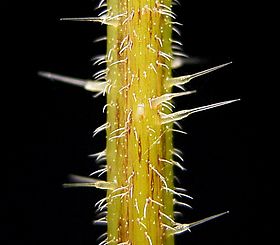
A stinging plant or a plant with stinging hairs is a plant with hairs (trichomes) on its leaves or stems that are capable of injecting substances that cause pain or irritation.
Other plants, such as opuntias, have hairs or spines that cause mechanical irritation, but do not inject chemicals. Stinging hairs occur particularly in the families Urticaceae, Loasaceae, Boraginaceae (subfamily Hydrophylloideae) and Euphorbiaceae.[1] Such hairs have been shown to deter grazing mammals, but are no more effective against insect attack than non-stinging hairs.[2] Many plants with stinging hairs have the word "nettle" in their English name, but may not be related to "true nettles" (the genus Urtica).
Though several unrelated families of plants have stinging hairs, their structure is generally similar. A solid base supports a single elongated cell with a brittle tip. When the tip is broken, the exposed sharp point penetrates the skin and pressure injects toxins. The precise chemicals involved in causing pain and irritation are not yet fully understood.
- ^ Cite error: The named reference
LookPoll91was invoked but never defined (see the help page). - ^ "Plant Resistance against Herbivory | Learn Science at Scitable". www.nature.com. Retrieved 2023-03-10.